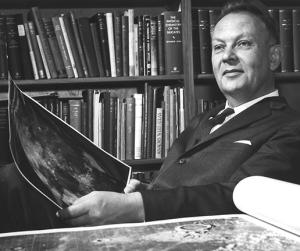Year born: 1905
Research Areas: Atmospheres and Moons

Early Life
Gerard was born in the Netherlands and loved stargazing from an early age. He had extraordinary eyesight that let him see stars four times fainter than most people could see. He studied astronomy at Leiden University and then moved to California, USA to work at the Lick Observatory.
Career Highlights
Gerard is often thought of as the father of modern planetary science because he was one of the first astronomers to focus his research on exploring what planets and moons are made from.
Gerard discovered Uranus’ moon Miranda and Neptune’s moon Nereid. Gerard also showed that Mars’ atmosphere is mainly carbon dioxide, that Saturn’s rings are made of ice, and correctly predicted what the surface of the Moon would be like to walk on. In the 1960s he was part of the team that identified landing sites for the Apollo mission.
Gerard famously theorised that there was a disk of icy objects beyond the orbit of Neptune. This region of our Solar System has been named the Kuiper belt in his honour.
Legacy
An asteroid, three craters and an escarpment in Antarctica have been named after Gerard, as well as the Kuiper belt.
